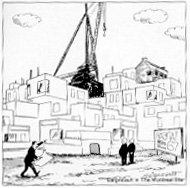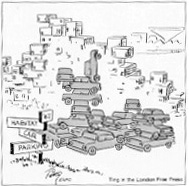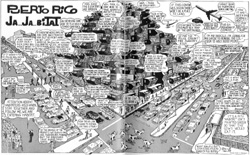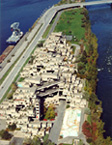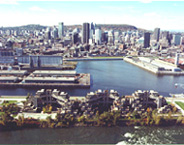In 1990, an article in the New York Times by architect and historian Witold Rybczynski singled out Habitat ‘67 as the “one [Canadian] work that has become known internationally and whose place in the history of architecture is assured.” We can only understand this statement by looking at Habitat’s past and present.
Since its inception, Habitat has been an innovative, controversial, emotion - generating enterprise, an enterprise that has succeeded admirably in demonstrating the enduring power of an original idea. It was not just an experiment in prefabrication and mass production, or in the use of a three-dimensional modular system as the organizing principle of an urban structure. An ongoing debate about the appropriation of two seemingly incompatible models: the suburban garden home and the high-rise apartment building challenged the architect’s ability to morph these models into a new way of city living. Habitat’s early critics might have denounced the structural feasibility of the project, its aesthetics, the life-span of concrete in a northern climate, or the architect’s lack of professional experience: ultimately, even before it was completed , seven million people toured the building as a foyer of the future home. For them, Habitat , with its post-Cubist geometry and its dual privileged relationship with the city and with nature, signaled a new way of building and of dwelling.
More than 30 years later, we see Habitat as the living, evolving organism it has always been. The early promise of the on-site prefabrication or an assembly-line construction did not materialize as the construction industry found other, more efficient modus operandi. However, the adaptability of the internal system to the changing needs of its inhabitants has been a resounding success. The much maligned concrete has weathered well and its maintenance has been described as a model in the industry. Recently, a visiting board member of the American Institute of Architects looked in astonishment at the vast expanse of the Habitat plaza where small cracks were being systematically injected and commented that a concrete building of Habitat’s ‘advanced age’ would most likely be condemned, or even demolished , in the United States.
We are sometimes reminded that, largely because of the obstacles to replicating the scheme on a truly mass scale, Habitat has strayed from its original promise as a blueprint for moderate-cost urban housing and that the families living in it today are determinedly middle-class. This is true. It was a community of middle-class tenants who, fifteen years ago, forged a special partnership with the intent of becoming not just mere co-owners, but managers of the building, with all the responsibilities attendant upon such an arrangement. The partnership gives back to the community through hosting professional and public events and through scholarship contributions to Montreal’s two architecture schools. What other residential building does that?
While there are other ‘temporary’ buildings surviving from that grand fiesta that was Montreal’s World’s Fair, Habitat is the only structure still used for the very purpose for which it was built. Its immediately recognizable form sets it in the company of other iconic buildings that arose as material and structural experiments in world exhibitions – the Eiffel Tower and the Crystal Palace among them. It is the most researched building among some 150 projects Safdie has designed. There are American students investigating its plumbing and French art historians writing a dissertation on the Habitat ‘discourse’ at the Sorbonne.
Ultimately, for all its importance, the future of Habitat ’67 is not so much in preserving a single building, or securing its infrastructure, but rather, in promoting the values that had accompanied Habitat’s growth: the synergy between innovation and political will; the facilitation, on a public scale, of original thinking; the validation, in a built form, of community ideals.
Since its inception, Habitat has been an innovative, controversial, emotion - generating enterprise, an enterprise that has succeeded admirably in demonstrating the enduring power of an original idea. It was not just an experiment in prefabrication and mass production, or in the use of a three-dimensional modular system as the organizing principle of an urban structure. An ongoing debate about the appropriation of two seemingly incompatible models: the suburban garden home and the high-rise apartment building challenged the architect’s ability to morph these models into a new way of city living. Habitat’s early critics might have denounced the structural feasibility of the project, its aesthetics, the life-span of concrete in a northern climate, or the architect’s lack of professional experience: ultimately, even before it was completed , seven million people toured the building as a foyer of the future home. For them, Habitat , with its post-Cubist geometry and its dual privileged relationship with the city and with nature, signaled a new way of building and of dwelling.
More than 30 years later, we see Habitat as the living, evolving organism it has always been. The early promise of the on-site prefabrication or an assembly-line construction did not materialize as the construction industry found other, more efficient modus operandi. However, the adaptability of the internal system to the changing needs of its inhabitants has been a resounding success. The much maligned concrete has weathered well and its maintenance has been described as a model in the industry. Recently, a visiting board member of the American Institute of Architects looked in astonishment at the vast expanse of the Habitat plaza where small cracks were being systematically injected and commented that a concrete building of Habitat’s ‘advanced age’ would most likely be condemned, or even demolished , in the United States.
We are sometimes reminded that, largely because of the obstacles to replicating the scheme on a truly mass scale, Habitat has strayed from its original promise as a blueprint for moderate-cost urban housing and that the families living in it today are determinedly middle-class. This is true. It was a community of middle-class tenants who, fifteen years ago, forged a special partnership with the intent of becoming not just mere co-owners, but managers of the building, with all the responsibilities attendant upon such an arrangement. The partnership gives back to the community through hosting professional and public events and through scholarship contributions to Montreal’s two architecture schools. What other residential building does that?
While there are other ‘temporary’ buildings surviving from that grand fiesta that was Montreal’s World’s Fair, Habitat is the only structure still used for the very purpose for which it was built. Its immediately recognizable form sets it in the company of other iconic buildings that arose as material and structural experiments in world exhibitions – the Eiffel Tower and the Crystal Palace among them. It is the most researched building among some 150 projects Safdie has designed. There are American students investigating its plumbing and French art historians writing a dissertation on the Habitat ‘discourse’ at the Sorbonne.
Ultimately, for all its importance, the future of Habitat ’67 is not so much in preserving a single building, or securing its infrastructure, but rather, in promoting the values that had accompanied Habitat’s growth: the synergy between innovation and political will; the facilitation, on a public scale, of original thinking; the validation, in a built form, of community ideals.

